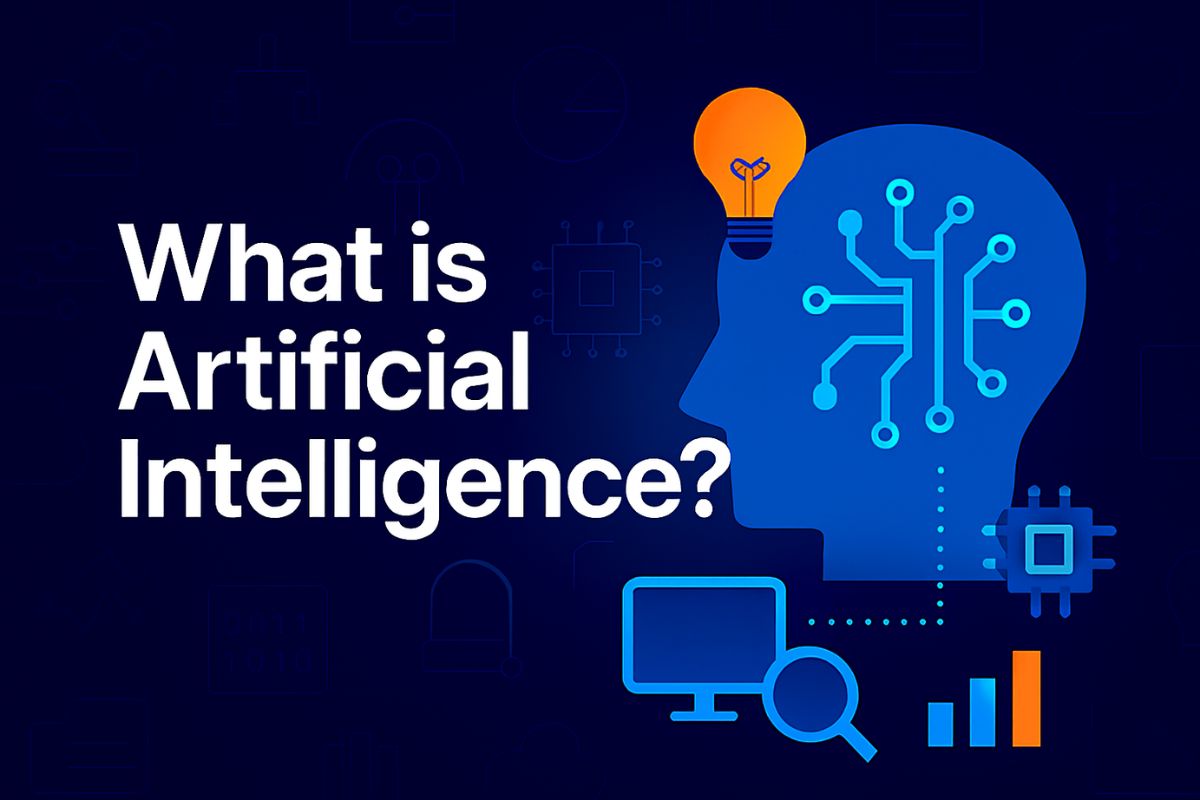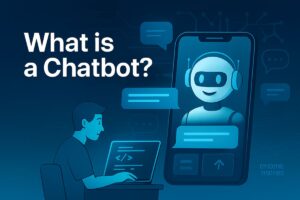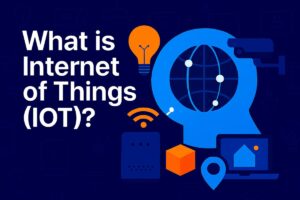Artificial Intelligence (AI) enables machines to mimic human intelligence, performing tasks like decision-making, language understanding, and problem-solving. This beginner-friendly guide explores what AI is, its history, types, real-world applications in India, tools, careers, learning paths, and key differences between AI, ML, DL, and NLP — designed for students and professionals in 2025.
Have you ever used Google Maps to avoid traffic? Or spoken to Alexa or ChatGPT for quick answers? These are real-life examples of Artificial Intelligence (AI) in action.
AI is no longer science fiction. It’s shaping how we live, work, learn, and interact — especially in a growing digital-first nation like India. Whether you’re a student preparing for the future or a professional looking to upskill, understanding AI is essential in 2025 and beyond.
In this blog, we’ll break down what Artificial Intelligence really means, how it works, its types, applications in India, career opportunities, tools, and how you can begin learning AI today.
What is Artificial Intelligence?
Artificial Intelligence is the ability of machines or computer systems to perform tasks that normally require human intelligence — such as problem-solving, learning, speech recognition, and decision-making.
How AI Works (Data → Algorithm → Output)
At its core, AI works by:
- Collecting Data – from sensors, users, or the internet
- Applying Algorithms – to learn from the data
- Making Decisions or Predictions – based on learned patterns
Example: When YouTube recommends your next video, it’s using AI to predict your interest from your past behavior.
Brief History & Evolution of AI
Milestones – From 1950s to ChatGPT
- 1950s – Alan Turing proposes the “Turing Test”
- 1956 – Term “Artificial Intelligence” coined at Dartmouth Conference
- 1997 – IBM’s Deep Blue defeats chess champion Garry Kasparov
- 2011 – Siri launches on iPhone
- 2022–2023 – ChatGPT, Bard, Gemini, and Claude revolutionize generative AI
AI in India – National Push
- INDIAai Portal launched by MeitY
- National Strategy for AI (NITI Aayog)
- AI in Agriculture, Education, Healthcare & Smart Cities
Types of Artificial Intelligence
Based on Capabilities
| Type | Description | Example |
|---|---|---|
| Narrow AI | Specialized in one task | Google Translate, Alexa |
| General AI | Can perform any intellectual task a human can | Still theoretical |
| Super AI | Surpasses human intelligence | Hypothetical Future AI |
Based on Functionalities
| Type | Characteristics | Example Use Case |
|---|---|---|
| Reactive Machines | No memory, only reacts | IBM Deep Blue |
| Limited Memory | Uses past data for decisions | Self-driving cars |
| Theory of Mind | Can understand human emotions | Not yet achieved |
| Self-aware AI | Has consciousness | Still hypothetical |
AI vs ML vs DL vs NLP vs Computer Vision
Definitions
- Artificial Intelligence (AI) – Human-like thinking by machines
- Machine Learning (ML) – AI that learns from data
- Deep Learning (DL) – ML using neural networks
- Natural Language Processing (NLP) – Understanding and generating human language
- Computer Vision (CV) – Machines seeing and interpreting images
Comparison Table
| Technology | Full Form | Function | Example Use Case |
|---|---|---|---|
| AI | Artificial Intelligence | Mimic human intelligence | Chatbots, Face ID |
| ML | Machine Learning | Learn from data | Email spam filters |
| DL | Deep Learning | Neural networks & deep learning | Self-driving cars |
| NLP | Natural Language Processing | Language processing | ChatGPT, voice assistants |
| CV | Computer Vision | Image & video recognition | Facial recognition, X-rays |
Real-Life Applications of AI in India
Education
- Byju’s, Vedantu, and Embibe use AI to personalize learning paths
- AI chatbots help with doubt-solving in real-time
- NPTEL and SWAYAM are adopting AI for adaptive testing
Healthcare
- AI-based diagnostics for tuberculosis, cancer, and COVID-19
- Telemedicine platforms powered by AI
- Government AI projects like eSanjeevani for rural care
Finance
- Razorpay, Paytm, and PhonePe use AI for fraud detection
- AI chatbots for 24×7 customer support
- Loan risk scoring with ML
Agriculture
- AI drones for crop health analysis
- Predictive weather models
- NITI Aayog pilot AI-based irrigation systems
E-commerce & Startups
- Zomato, Swiggy use AI for delivery route optimization
- Flipkart uses recommendation engines
- Startups like CropIn use AI for smart farming
Benefits and Risks of Artificial Intelligence
Benefits
- Automates repetitive tasks
- Analyzes large data sets in seconds
- Enables faster and smarter decisions
- Improves personalization (marketing, education, health)
Risks
- Job displacement in certain sectors
- Bias in AI algorithms
- Privacy concerns
- AI misuse (deepfakes, scams)
How to Start Learning Artificial Intelligence in 2025
Skills You Need
- Basic Math (Algebra, Probability, Linear Algebra)
- Python programming
- Logical & critical thinking
- Patience for debugging
Learning Path
- Start with Python (learn from YouTube: Apni Kaksha, CodeWithHarry)
- Learn AI basics from:
- Coursera – Andrew Ng’s AI courses
- NPTEL – AI & ML by IIT Madras, IIT Hyderabad
- Google AI – Free beginner courses
- Practice on:
- Kaggle (competitions + datasets)
- GitHub (clone & learn projects)
- AI Experiments by Google
Popular Tools & Libraries for AI
| Tool/Library | Purpose | Free? |
|---|---|---|
| Python | Primary AI language | Yes |
| TensorFlow | Deep learning library | Yes |
| Scikit-learn | Traditional ML models | Yes |
| OpenCV | Computer vision library | Yes |
| HuggingFace | NLP models (Transformers) | Yes |
| Google Colab | Free GPU-enabled notebook | Yes |
Career Opportunities in AI (India-Specific)
Job Roles
- AI Engineer
- NLP Engineer
- Computer Vision Specialist
- Data Scientist
- ML Ops Engineer
Salary Expectations (₹ Per Annum)
| Experience Level | Salary Range |
|---|---|
| Entry-level | ₹6–8 LPA |
| Mid-level | ₹10–15 LPA |
| Senior roles | ₹20–40 LPA+ |
Top Indian Employers
- Infosys, TCS, Wipro, Accenture
- Flipkart, Zoho, Freshworks, Meesho
- DRDO, ISRO, CDAC
- AI-focused startups: Fractal, Uniphore, CropIn
Common Misconceptions About AI
- AI = Robots: Not always. AI powers software too.
- AI will steal all jobs: AI will automate tasks, but also create new opportunities.
- AI is conscious: Not true. Current AI lacks self-awareness.
- Anyone can build AI overnight: It takes time and consistent learning.
Tools & Free Resources
| Resource | Purpose |
|---|---|
| INDIAai.gov.in | Govt AI portal, projects, scholarships |
| Google AI | Free tutorials, experiments |
| Kaggle | Projects, datasets, competitions |
| HuggingFace | Pre-trained models for NLP, vision |
| GitHub | Open-source code to explore & learn |
Conclusion
AI is no longer a “future technology.” It’s the present and the future — transforming industries, education, and daily life in India. For students, professionals, and entrepreneurs, learning AI is no longer optional — it’s essential.
Start small. Stay consistent. Build real projects. And keep exploring with curiosity.
Loved this guide?
- Share it with your friends or classmates
- Explore more tech blogs on Schoolication.com
- Drop a comment to share your AI journey!
FAQs
1. What is artificial intelligence in simple words?
AI is when machines perform tasks that require human intelligence like learning, thinking, and decision-making.
2. Is AI the same as machine learning?
No. ML is a subset of AI. AI includes ML, NLP, DL, and more.
3. What are the top applications of AI in India?
Education (Byju’s), healthcare (AI diagnostics), agriculture (crop prediction), and fintech (fraud detection).
4. Can I learn AI without a tech background?
Yes! With free tools, beginner courses, and basic logic, anyone can start learning AI.
5. Which jobs will AI create or destroy?
AI may automate data entry or testing jobs but will create demand for AI engineers, data scientists, and ethical AI experts.
6. How can I start a career in AI in India?
Start with Python, learn AI concepts online, do internships, and build projects on GitHub or Kaggle.
7. Is AI dangerous or beneficial?
It depends on how it’s used. AI is powerful, but needs ethical oversight and balanced implementation.



